|
| |
| |
DENIS
GIFFORD'S
MONSTERS OF THE MOVIES
(1977)
|
|
Monster #14 - Dr
Caligari
|
|
| |
| |
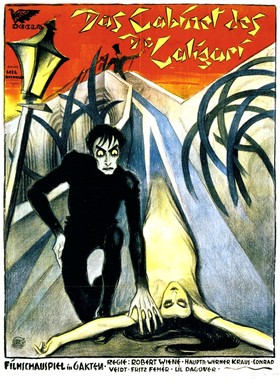 |
|

Germany,
1920
A Decla Bioscope
Filmgesellschaft Berlin Production
72 mins, black & white, silent, 1.33:1 aspect
ratio
Shot on 35mm film, at 18 fps
Director - Robert Wiene
Screenplay - Carl Mayer, Hans Janowitz
Cinematographer - Willy Hameister
Production Design - Walter Reimann, Walter
Röhrig, Hermann Warm
Set Design - Hermann Warm (uncredited)
Werner
Krauss (Dr. Caligari), Conrad Veidt (Cesare),
Friedrich Fehér (Franzis), Lil Dagover (Jane),
Hans Heinrich von Twardowski (Alan), Rudolf
Lettinger (Dr. Olsen)
|
|
| |
| Monsters of the Movies
not only introduced my 13-year old self to a lot of
ghouls, monsters and fiends I had never even heard of
before, it also offered me a first glimpse of the
"classics" and thus a sense of history and the
roots of the genre. |
| |
Reading my way through Denis
Gifford's alphabetic roll-call, monster number 14
was the first introduction to the horror cinema's
first generation of creepy terrors - and with
such a mysterious name, Dr Caligari immediately
caught my attention.
The image
selected by Denis Gifford for this entry -
showing actor Werner Kraus as the insane
hypnotist and psychiatrist Dr Caligari and Conrad
Veidt as the somnabulist who is controlled by
Caligari for his evil schemes of murder and
mayhem - had a decidedly eerie feel to it, which
(of course) even increased my interest.
My 13-year
old self had never heard of this movie before,
and I only started to grasp its impact on cinema
history and its importance for the horror genre a
few weeks later, when buying Gifford's Pictorial History of Horror Movies
(which featured a more in-depth review and plenty
more still images).
|
|
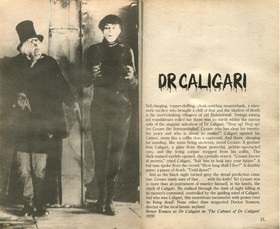
(Carousel Books / Transworld
Publishing)
|
|
| |
| Filmed in
December 1919 and January 1920 at the Lixie
Atelier in Weissensee (Berlin), Das Cabinett des Dr
Caligari is considered the quintessential work of
German Expressionist cinema, featuring an extremely dark
and twisted visual style, highlighted by structures and
landscapes that lean and twist in unusual angles,
sharp-pointed forms, and shadows and streaks of light
painted directly onto the sets. |
| |
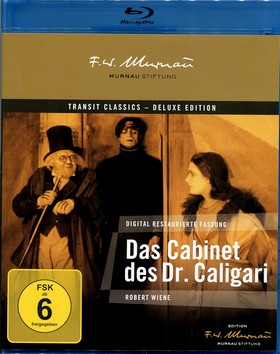
|
|
But back in
1977 I only had an inkling of all of this, and it
took me a very long time to actually get to see
the movie - inspite of the deep impression the
film stills made on my 13-year old self and my
subsequent interest in the genre. In 2012, the
Friedrich-Wilhelm-Murnau foundation decided to
produce a completely new digital restoration of
the movie - the first such project to make
extensive use of digital restoration tools and
color grading and to work with the six known,
differently tinted and toned historical prints
from the 1920s (Flueckiger, 2015).
In addition to these, several other (monotone
black & white) prints were used, such as a
1935 16mm print and the 1919 black & white
camera negative (no 1919 colored nitrate print
survives). Every one of these surviving prints
has its issues (missing scenes, scratches,
chemical defects, etc)., so different parts from
the various prints had to be scanned and
combined.
The result was first shown at the 2014 Berlin
Film Festival and subsequently released on
Blu-ray. The meticulous approach to the
restoration has worked wonders, especially
considering the age of the material, and the
substantial extras docukenting the various
aspects of the restoration work are fascinating
by themselves.
|
|
| |
| In these days of CGI, watching a
feature length silent movie is a very different
experience that requires the right mindset. In the case
of Das Cabinett des Dr Caligari, however, it
only takes a few minutes of adjusting - not the least
because the movie isn't actually black and white, but
tinted in different shades of colour, e.g. using blue
tint for night shots. |
| |
In that respect, Das Cabinett
des Dr Caligari also taught me that our idea
of what early "black & white"
movies look like is, actually, quite a bit off
the mark.
"Seeing films
as early audiences would have seen them
provides a powerful visual surprise."
(Monaghan, 2016)
The film contains 141
scenes and features a framing story that
ultimately reveals itself as putting a
fundamental twist on the entire movie - yet
another novel and thereafter often copied plot
device. The main story of Das Cabinett des Dr
Caligari has a distinct abstract quality
that often creates an unreal atmosphere, not
unlike a bad dream. In terms of plot and
characterisation, however, there is very little -
viewers aren't told much about the why, which
makes the unfolding terror and its visuals all
the more menacing.
Perhaps not surprisingly -
given both the age and the reputation of the film
- there are a number of conjectures made by
various film historians, ranging from a possible
involvement of Fritz Lang to potential changes
made to the script by the producer.
Likewise, different explanations for the
origin of the name Caligari exist, but so far
none has proven bulletproof (except that the
character's name is spelled Calligaris in the
only known surviving script - other names differ
from those used in the final film version as
well).
|
|
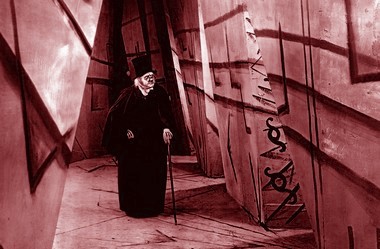
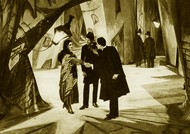 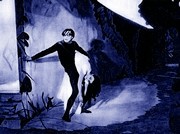
|
|
| |
| Denis Gifford's compilation of 46
horror movies included both the highly influential as
well as the highly forgettable, and sometimes somewhere
in-between, but Cabinett des Dr Caligari may
well be the most lastingly influential film on Gifford's
list, since its profound and lasting impact went far
beyond the horror genre. |
| |
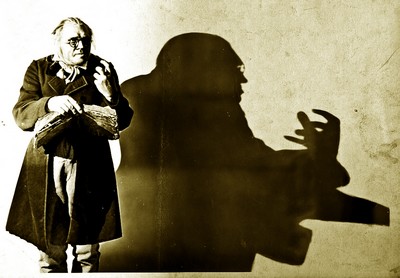 |
|
Many of the film's Expressionist
elements (such as the methods of using light and
shadow to represent impending danger as well as
the dark psychology of its characters) can be
found in subsequent German movies such as
Murnau's Nosferatu (1922, also included in
Gifford's Monsters of the Movies) or
Lang's Metropolis (1927). The
film's success also influenced the thinking
behind how to shoot a movie, with many directors
in Europe and the States moving away from
location shootings and onto studio stages.
There are traces of Caligari
to be found in American noir movies from the
1940s and 1950s, and you can clearly see glimpses
of the film in Hitchcok's work as well, both in
tterms of visual style (with dark and shadowy
settings and very stylized and sometimes even
abstract camera work) as well as narrative tone
(the innocent being subject to suspicion).
|
|
| |
| |
| |
|
| |
| |
| |
 |
|
Denis Gifford on The
Cabinet of Dr Caligari
in A Pictorial History of
Horror Movies (1973)
"The
Cabinet of Dr Caligari is still not only
a great horror film, it is a classic of
cinema."
|
|
 |
|
| |
|
| |
| |
| SOURCES FLUECKIGER
Barbara (1975) "Color
Analysis for the Digital Restoration of Das Cabinet des
Dr. Caligari", The Moving Image Vol. 15
No. 1 (Spring 2015), University of Minnesota Press
GIFFORD Denis
(1973) A Pictorial History of Horror Movies,
Hamlyn
MONAGHAN Peter
(2016) "Reproducing
Film Colors, and Their Significances", Moving
Image Archive News, 17 March 2016
|
| |

Back
to main index page
|
| |
|
| |
The illustrations presented here are
copyright material.
Their reproduction in this non-commercial review
and research context is considered to be fair use
as set out by the U.S. Copyright Act of 1976, 17
U.S.C. par. 107
and in accordance with the the Berne Convention
for the Protection of Literary and
Artistic Works.
All images from
Monsters of the Movies
(Carousel/Transworld) were scanned from my
personal copy purchased in 1977
All images of Blu-ray or DVD covers were scanned
from my personal copies
Page created 3
September 2023
Last updated 20 October 2023
(c)
2023

|
|
| |












